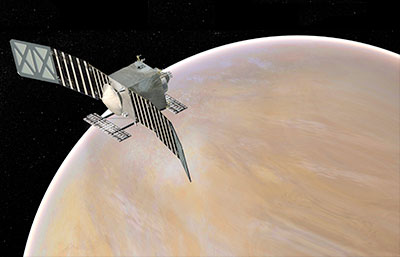Lockheed Martin to Help NASA Uncover Mysteries of Venus with VERITAS SpacecraftLockheed Martin has a major role in NASA's long-anticipated return to Venus
To learn more about how terrestrial planets evolve over time, NASA selected the VERITAS mission for its Discovery Program, bound for Venus. Lockheed Martin will design, build and operate the spacecraft. The mission will launch in 2026 and will study Venus' dense atmosphere, topography and geologic processes in great depth.
The mission aims to discover how Venus – which may have been the first potentially habitable planet in our solar system – became inhospitable to life. It represents NASA's return to Earth's sister planet after more than three decades.
VERITAS – which stands for Venus Emissivity, Radio Science, InSAR, Topography & Spectroscopy – will have its science and operations managed by NASA's Jet Propulsion Laboratory in Southern California.
Why Does Venus Matter?
Though scientists believe it was once similar to our home planet, Venus evolved to be much different – and far less habitable – than Earth.
As Earth's own climate and geology evolve, interest in returning to Venus has surged because the planet currently suffers from a runaway greenhouse gas effect.
Over millennia, water that may have once existed on Venus' surface evaporated and carbon dioxide built up in the atmosphere – leading to a present-day surface temperature that's hot enough to melt lead.
Previous missions to Venus have even provided tantalizing clues that the planet may have once harbored a liquid ocean.
VERITAS will build on those findings, helping scientists better understand the existence of past life on Venus and how its atmosphere and geology may have influenced its ultimate outcome.
Science from this mission could provide clues about Earth's own future and will also help inform future missions to the planet.
Studying Venus' Geology with VERITAS
As an orbiter that draws on heritage from the Lockheed Martin-built MAVEN spacecraft at Mars, VERITAS will give scientists the most detailed maps ever produced of Venus' obscured landscape.
When VERITAS arrives at Venus, the orbiter will use a special technique called aerobraking to carefully insert itself into an optimal science position in the planet's orbit.
As the spacecraft circles Venus in four cycles near the planet's poles, two extremely sensitive imagers will capture things like volcanic activity, tectonics and outgassing of any life-related compounds like water or carbon.
Legacy of Planetary Exploration
VERITAS is the eighth NASA Discovery Program mission Lockheed Martin has been part of.
NASA's Discovery Program-class missions are capped at a specific, relatively low cost. They are managed for NASA's Planetary Science Division by the Planetary Missions Program Office at Marshall Space Flight Center in Huntsville, Alabama. The missions are also designed and led by a principal investigator, who assembles a team of scientists and engineers to address key science questions about the solar system.
Over 50 years, Lockheed Martin has helped NASA explore every planet of our solar system, and continues to develop new technologies for future space missions.
The company also supported NASA on Magellan, the agency's prior mission to Venus 30 years ago. Lockheed Martin built that spacecraft, which produced the first ever maps of Venus' surface from orbit.
Now, the team builds on that legacy of discovery with VERITAS.












